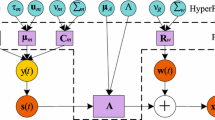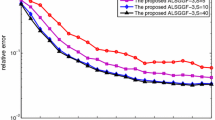Abstract
This paper presents a new Maximum Likelihood (ML) based approach to the separation of convolutive mixtures of unobserved sources in the presence of Additive Gaussian Noise (AGN). The proposed method proceeds in two steps. First, the mixing system coefficients are estimated in the ML sense and, afterwards, this information is employed to attain source separation according to either the ML or the linear Minimum Mean Square Error (MMSE) criteria. System coefficient estimation is carried out in a block-iterative way using an extension of the Expectation Maximization (EM) method. Both deterministic and stochastic (Monte Carlo) implementations of the resulting estimation algorithm are considered. The proposed algorithms rely on the knowledge of the sources joint probability density function (p.d.f.). This is a fairly realistic assumption in applications such as digital communications but computer simulations reveal that it is not an stringent requirement. The proposed estimation algorithm can be successfully used with a tentative p.d.f. when this is not known a priori.
Similar content being viewed by others
References
C. Jutten and J. Herault, “Blind Separation of Sources I. An Adaptive Algorithm Based on Neuromimetic Architecture,” Signal Processing, vol. 24,no. 1, 1991, pp. 1-10.
D.T. Pham and P. Garat, “Blind Separation of Mixture of Independent Sources through a Quasi-Maximum Likelihood Approach,” IEEE Trans. Signal Processing, vol. 45,no. 7, 1997, pp. 1712-1725.
J.F. Cardoso, “Infomax and Maximum Likelihood for Blind Source Separation,” IEEE Signal Processing Letters, vol. 4,no. 4, 1997, pp. 112-114.
A.J. Bell and T.J. Sejnowski, “An Information-Maximization Approach to Blind Separation and Blind Deconvolution,” Neural Comput., vol. 7,no. 6, 1995, pp. 1004-1034.
J.F. Cardoso, “Blind Signal Separation: Statistical Principles,” Proceedings of the IEEE, vol. 86,no. 10, 1998, pp. 2009-2025.
J.K. Tugnait, “Adaptive Blind Separation of Convolutive Mixtures of Independent Linear Signals,” Signal Processing, vol. 73,no. 1/2, 1999, pp. 139-152.
N. Charkani and Y. Deville, “Self-Adaptive Separation of Convolutively Mixed Signals with a Recursive Structure. Part I: Stability Analysis and Optimization of Asymptotic Behaviour,” Signal Processing, vol. 73,no. 1/2, 1999, pp. 225-254.
A. Hyvarinen, “Noisy Independent Component Analysis by Gaussian Moments,” in Proc. of the 1st Int. Workshop on ICA and Signal Sep., January 1999, pp. 473-478.
G.J. McLachlan and T. Krishnan, The EM Algorithm and Extensions, Wiley Series in Probability and Statistics, New York: John Wiley & Sons, 1997.
F. Kai-Tai and Z. Yao-Ting, Generalized Multivariate Analysis, Science Press Beijing and Springer-Verlag, 1990.
O. Cappé, A. Doucet, M. Lavielle, and E. Moulines, “Simulation-Based Methods for Blind Maximum-Likelihood Filter Identification,” Signal Processing, vol. 73,no. 1/2, 1999, pp. 3-25.
J.G. Proakis, Digital Communications, Singapore: McGraw-Hill, 1995.
S. Verdú, Multiuser Detection, Cambridge, UK: Cambridge University Press, 1998.
S. Haykin, Adaptive Filter Theory, 3rd edn., Prentice Hall Information and System Sciences Series, Englewood Cliffs, NJ: Prentice Hall, 1996.
Author information
Authors and Affiliations
Rights and permissions
About this article
Cite this article
Míguez, J., Castedo, L. Maximum Likelihood Unsupervised Source Separation in Gaussian Noise. The Journal of VLSI Signal Processing-Systems for Signal, Image, and Video Technology 31, 7–18 (2002). https://doi.org/10.1023/A:1014437019997
Published:
Issue Date:
DOI: https://doi.org/10.1023/A:1014437019997




